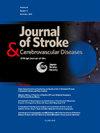急性再灌注治疗后受损的肱血流介导的扩张与出血转化的相关性。
IF 2
4区 医学
Q3 NEUROSCIENCES
Journal of Stroke & Cerebrovascular Diseases
Pub Date : 2025-02-01
DOI:10.1016/j.jstrokecerebrovasdis.2024.108191
引用次数: 0
摘要
目的:出血性转化(HT)是再灌注治疗的一个重要并发症,经常导致不良的功能结局。我们的目的是探讨内皮功能(通过血流介导扩张(FMD)评估)与接受急性再灌注治疗的患者发生HT之间的相关性。材料和方法:在我们的回顾性分析中,我们调查了急诊大血管闭塞(ELVO)患者,他们接受了急性再灌注治疗并通过FMD进行评估,计算公式为%FMD = (峰值直径 - 基线直径)/基线diameter×100。根据欧洲急性卒中合作研究(ECASS)的定义对HT进行分类。通过多因素分析,我们探讨了与HT相关的因素,考虑了脑卒中的机制,并深入探讨了FMD与HT的关系。结果:本研究共纳入172例患者,45.3%的患者经历了HT。与HT相关的因素包括:美国国立卫生研究院卒中量表(NIHSS)初始得分较高[7 (5-10)vs. 10 (8-14);结论:内皮功能障碍(以FMD %受损为指标)是急性再灌注治疗后HT的潜在预测因子,尤其是LAA患者。本文章由计算机程序翻译,如有差异,请以英文原文为准。
Correlation between impaired brachial flow-mediated dilation and hemorrhagic transformation after acute reperfusion therapy
Objective
Hemorrhagic transformation (HT) represents a critical complication of reperfusion therapy, often resulting in unfavorable functional outcomes. Our objective was to explore the correlation between endothelial function, assessed through flow-mediated dilation (FMD), and the occurrence of HT in patients undergoing acute reperfusion therapy.
Materials and methods
In our retrospective analysis, we investigated patients with emergent large vessel occlusion (ELVO) who underwent acute reperfusion therapy and assessment through FMD, calculated as %FMD = (peak diameter − baseline diameter)/baseline diameter×100. HT was categorized according to the European Cooperative Acute Stroke Study (ECASS) definition. Through multivariate analysis, we explored factors associated with HT, considering stroke mechanisms, and delved into the relationship between FMD and HT.
Results
A total of 172 patients were included in this study, with 45.3% experiencing HT. Factors associated with HT included high initial National Institute of Health Stroke Scale (NIHSS) scores [7 (5–10) vs. 10 (8–14); P <0.001], receiving tissue plasminogen activator (tPA) (21.3 vs. 39.7%; P<0.001), undergoing endovascular therapy (EVT) 10.6 vs. 26.9%; P <0.001), and impaired %FMD (6.2±2.5 vs. 4.9±1.8; P = 0.022). In a subgroup analysis of patients with cardioembolism, receiving EVT was significantly associated with HT (reference: tPA only; adjusted odds ratio [aOR] = 7.000; 95% confidence interval, 1.173–41.759; P = 0.033). In those with large artery atherosclerosis (LAA), a higher initial NIHSS score (aOR = 1.274; 1.082–1.499; P = 0.004) and impaired %FMD (aOR = 0.632; 0.402–0.995; P = 0.047) were independently associated with HT.
Conclusions
Endothelial dysfunction, indicated by impaired %FMD, emerges as a potential predictor of HT following acute reperfusion therapy, particularly in patients with LAA.
求助全文
通过发布文献求助,成功后即可免费获取论文全文。
去求助
来源期刊

Journal of Stroke & Cerebrovascular Diseases
Medicine-Surgery
CiteScore
5.00
自引率
4.00%
发文量
583
审稿时长
62 days
期刊介绍:
The Journal of Stroke & Cerebrovascular Diseases publishes original papers on basic and clinical science related to the fields of stroke and cerebrovascular diseases. The Journal also features review articles, controversies, methods and technical notes, selected case reports and other original articles of special nature. Its editorial mission is to focus on prevention and repair of cerebrovascular disease. Clinical papers emphasize medical and surgical aspects of stroke, clinical trials and design, epidemiology, stroke care delivery systems and outcomes, imaging sciences and rehabilitation of stroke. The Journal will be of special interest to specialists involved in caring for patients with cerebrovascular disease, including neurologists, neurosurgeons and cardiologists.
 求助内容:
求助内容: 应助结果提醒方式:
应助结果提醒方式:


